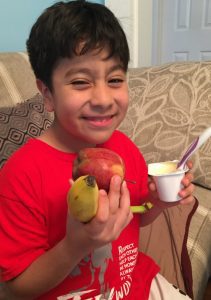Smart Snacks Standards
Is your school smart snack savvy? The “Smart Snacks in School” rule set standards for all foods and beverages sold in schools that participate in the national school meal program.
Read MoreHealthy snacking is crucial for children to fuel their growing bodies, stay focused and remain engaged throughout the day. Aim to make snack time at home healthy and fun with a few simple activities and a little thinking outside of the snack box.
Explore the Mind-Body Connection
Food is our fuel for both the body and the mind. It helps us to be active and grow while also influencing how we feel. Invite children to reflect on how certain foods make you feel after eating them (e.g. energized, sleepy, etc.) Exploring this connection helps children choose foods that make them feel their best and make healthy choices.

Talk to your children about hunger cues by asking them how they feel when they are hungry versus full. Encourage children to pause and think about how they are feeling when they ask for a snack; are they hungry, bored, or both? It is important for children to learn how to listen to hunger cues so that they can develop healthy habits that support their body’s needs.
Incorporate Balance
Each food group (grains, dairy, proteins, fruits, and vegetables) provides the body with essential vitamins and nutrients. Invite children to explore the nutrient makeup of their food and strive for a nice balance across food groups throughout the day. Keep a log, a journal or use to empower children to select healthy options.
Be mindful of portion sizes! Snacks should be smaller in portion and should be just enough to hold your child over until the next.
Create Food Art or Spend Time in the Kitchen
The best part about healthy foods is that most of them are super colorful! Become an artist and get creative while playing with food. For an added challenge, see how many foods from the 5 food groups, you can include in your masterpiece! Involving children in the kitchen is by far, the best way to teach them about the importance of healthy eating. Whether with food art, kitchen experiments or cooking together as a family, this hands-on learning creates an engaging environment where children can explore food and nutrition while developing critical thinking skills, explore personal preferences and tap into their own creativity.
Think on the Fly
Healthy snacking doesn’t have to be fancy. Sometimes, cheese and crackers are the easiest and quickest option when you’re in a time crunch. To save time, use a Sunday afternoon to chop bell peppers, carrots, and celery sticks for the upcoming week. Rather than put pressure on yourself, explore alongside your child and discover simple favorites together. Take a pantry or refrigerator inventory and see what delicious snacks you can come up with using what you have on hand!
AFHK Staff Favorite Recipes:
Involve your children in the making of snacks as much as possible. Everything tastes better when you make it yourself!
Use weekends to prepare certain snacks ahead of time. If you can, stick them in the freezer until they are needed or store in the refrigerator in Tupperware for quick access.
Incorporate as many fresh ingredients as possible. Next time you’re at the grocery store, pick 2-3 favorite fruits and vegetables to snack on throughout the week.
Come Prepared by packing a snack for on-the-go excursions like going to the park or grocery shopping. Little snacks throughout the day between meals will help children keep bellies full.
Talk with children about the importance of healthy snacking and the time and place for special treats. Snacks are meant to fuel the body in between meals, so encourage them to think of swaps (e.g. a yogurt parfait in lieu of ice cream) and identify other times where a special teat might make more sense.
For more activities and ideas like this one, be sure to sign up for our news and updates. And if you like what you see, please donate to support our work creating more ways to help build a healthier future for kids.
Categories: Nutrition & Healthy Eating, At Home, Digital Resource